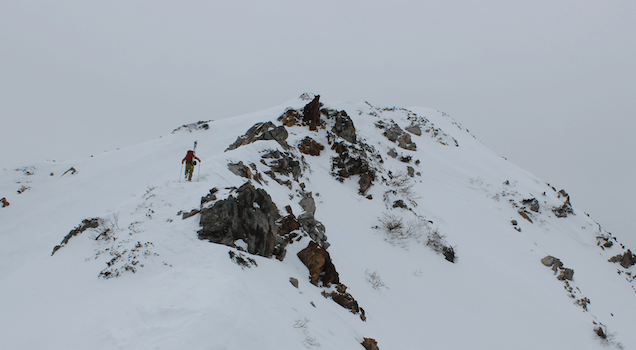
Backcountry skiing, when done safely with a good crew, is a whole heckuva lot of fun. Here’s a few tips I’ve learned that make it more about getting good turns with a grin on your face and less like a cold, sweaty, uncomfortable walk in ski boots (which, I have to admit, isn’t entirely untrue).
1. Get learned
It should go without saying that education, backed up with experience, is the cornerstone of getting more skiing in the backcountry. Take classes, practice your rescue and pit digging skills, contribute observations to your local avalanche center or apps like Avatech, and find ways to bring avalanche safety into your backcountry program. Find partners who can teach you things, and partners with the same level of knowledge so you can grow as a team.
Not getting slid means more time shredding, and it will keep your mom happier.
2. Micromanage your gear
Get organized at home, the night before—don’t be the person with stuff flying everywhere when they need to find anything in their bag.
There’s a right balance of gear for every tour, whether it’s three weeks on Denali or just an afternoon out the gate at your local hill. Take note of what you need for different scenarios, find gear that fits your needs, and actively make adjustments when you aren’t using certain pieces. You will almost always fill your pack to capacity, so if you have a tendency to bring the kitchen sink, get a bag that forces you to think more critically by virtue of less volume.

I consistently use a different kit of outerwear while touring than I do while riding lifts. Softshell pants are a huge key to sweating less, gaining flexibility, and enjoying yourself more. A shell for your top is nice, and a puffy jacket (synthetic or down depending on the conditions you expect to find and where you live) that goes over your shell offers a haven of warmth for digging pits and waiting for your slower friends. Dry base layers and extra gloves/mitts can be the difference between suffering and enjoying yourself on the third lap.
A few things that don’t leave my touring pack: shovel, probe, snow saw, stuff sacks, various length ski straps, duct tape, Leatherman, headlamp.
3. Treat your feet right.
Even more than lift riding, your feet can take a beating with a full backcountry day. I’m also quick to tell friends that boots are the most essential piece of ski gear to get right. Be sure to get your boots fitted by someone who knows what they’re doing, do any punching/customization work necessary, and consider a Superfeet insole to replace whatever stock junk came with your boots. There’s a lot to be said for supported arches and toasty toes when other things are going wrong, and painful boots are a consistent misery that you would will regret every step of the way.
4. Master the art of backcountry snacking.
The real benefit of going uphill isn’t just that you get to ski back down—you’ve also earned a hefty dose of caloric therapy. I like to snack consistently throughout the day with food like bars, blocks, and nut butter gels. Tuck them in a pants pocket to warm them up before eating. Add in a fewer bigger options like salad wraps or sandwiches to keep things topped off, and these I eat at the top of a lap to avoid the dreaded stomach lug while trying to break trail back uphill. Sometimes, the right chocolate bar in your lunch sack is just enough motivation to make it out before dark.

Don’t forget to drink, too. Start by having a bottle out in the car on the way to the trailhead. Splitting my day water needs 50/50 between a thermos of tea/collapsable water bottle does right by me, and offers a hot option for chilly ridge tops.
If you’re anything like me, getting back to the car is a hungry time. Pack ahead with good options, both food and drink, and you won’t have to free solo a whole, PARTY SIZE bag of Ruffles to murder your hangry cravings on the way home (not to say that you shouldn’t do this anyway).
5. Focus on technique, not just speed.
There’s a tendency to try to get more efficient by doing things faster: go uphill fast, transition fast, ski fast. Yet, dialing in the sequence of your transitions, cutting lower angle switchbacks, or lightening your pack of extra nonsense you don’t need are all ways to make more skiing happen without feeling the need to get a rando race suit. Travel tests add extra information to your snow knowledge of an area, and you can do them as you move. Staying on your heels and grooving your kick turns is more advantageous than being a flailing, uphill maniac.
Bonus: Have fun, silly.
If you’re ahead on a rise, make snowballs and rain them on the rest of the crew. Get everyone into the pit, and then cut a fart. Try skiing in walk mode for a lap. Laugh at poor sunscreen application and when people fall in powder with their pit zips open. Yodel. Yell obscene things at quiet vistas and nothing in particular. Sing, especially if you can sing off-key renditions of terribly catchy pop hits. Argue constantly about everything. Set Hobbit height skin tracks for your tall buddies. Do the monster mash and reenact Monty Python’s Ministry of Silly Walks on the skin track. Pizza when you should french fry.
Want to learn more tips and tricks, follow David Powder Steele's adventuresqu on Facebook and Instagram

